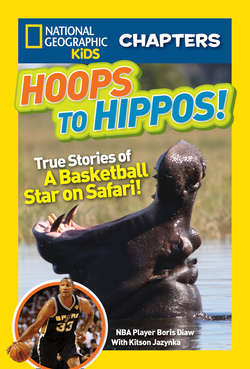Читать книгу National Geographic Kids Chapters: Hoops to Hippos!: True Stories of a Basketball Star on Safari - Kitson Jazynka - Страница 9
Оглавление
After my rookie, or first, year in the NBA, I finally had time to go back to Senegal. I called Martin, and we organized a trip to visit family. I bought a camera at the airport in Paris. It made me think of the camera I had when I was seven. Just like then, I wanted to remember what I did and saw on my trip.
I took pictures of people in Dakar while they waited for buses or crossed the street. The city was so colorful. The wild areas we visited were colorful, too. One day, we visited a place called Lake Retba (sounds like ret-BAH), which is known as the “pink lake.” A special bacteria (sounds like back-TEER-ee-uh) growing in the water turns it pink. I took pictures of the lake and the birds. I had fun figuring out how my new camera worked.
A year later, after another season playing in the NBA, I returned to Africa again. But this time, I went to the country of South Africa. I planned to go on a true safari. I wanted to watch wild predators (sounds like PRED-uh-ters) hunt in their natural habitat. I bought better camera equipment. And I invited my mom to join me.
We went to Kruger National Park. When we got there, the thing that struck me was the peace. No noise, no cars, no nothing. My phone didn’t work. I couldn’t even get text messages. That was a good thing! It felt like those days as a kid, when I used to go camping.
I usually love to sleep late in the morning. But I was excited about heading out on our morning game drives before dawn. “Game” are the animals you see while driving around a huge park like this one. Our first morning, we drove through the bush in the dark. We rode in a vehicle without a roof or sides. It easily went through tall grass and bushes, and even over small trees. Sticky spiderwebs stuck to my face as we rode along. Branches scraped our arms. We could hear birds squawking and insects buzzing. It was great.
The tracker—the person who looks and listens for signs of animals—sat in a special chair on the hood of the vehicle. He scanned the darkness with a bright light. He kept an eye on the dirt road for tracks. He sniffed the air for fresh poop. I wondered what animals we would see.
The tracker also listened for clues, such as the alarm calls that baboons make when big predators are near. We saw a hyena (sounds like hi-EE-nuh) running along the road. It turned and looked at us with glowing yellow eyes.
At one point, the guide stopped the vehicle. He reached into a low tree. When he pulled his arm out, a green chameleon (sounds like kuh-MEEL-yun) clung to his hand. It was cool to see the little reptile’s green toes and its big rotating eyes so close up. The guide placed it back on a branch, and we were off again.
Did You Know?
A chameleon shoots out its long, sticky tongue to snag an insect, then draws the meal back to its mouth.
After the sun came up, we saw a herd of elephants. The guide turned off the vehicle. We sat there not making a sound. It was like we were part of the herd. We listened as the elephants whispered to one another in rumbles. We watched them shove the tall grass into their mouths with their trunks. I noticed a baby elephant standing in between the legs of his mom. He was so small!
That day, we also watched lions sleeping in the shade. We saw a rhino drinking at a water hole. Lions, rhinos, and elephants are three of the animals in the “big five.” These are the five animals people most want to see on safari. The other animals in the big five are leopards and African buffalo. At Kruger National Park, we saw all of the big five.
Though I wasn’t a rookie basketball player anymore, I was definitely a rookie photographer. I took lots of pictures. I might take 200 pictures of an elephant eating leaves! Back at the lodge, I would have to sort through hundreds of almost identical pictures. I realized I had to think before I clicked. The mistakes I made helped me learn to be a better photographer.
Like me, many people travel to South Africa to see the “big five.” On one of my trips, a safari guide clued me in about the “little five.”
They’re also fun to see. They are the:
1. rhinoceros beetle
2. elephant shrew
3. buffalo weaver
4. leopard tortoise
5. ant lion
No matter what animal I saw, big or small, it always fascinated me.
